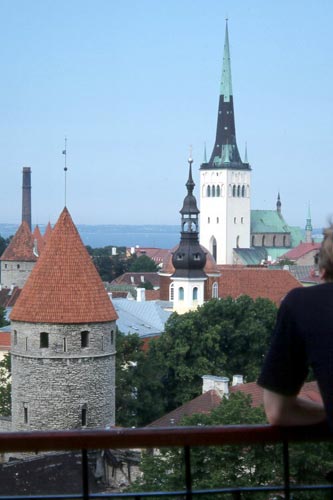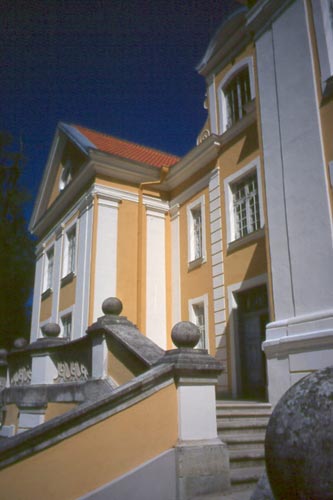
A medieval wall and towers enclose Tallinn's Old Town.
AN ESTONIAN INTERLUDE
Bessie Too and I arrived bright and early in the amazingly well preserved medieval city of Tallinn, capital of Estonia. Lots of tourists were in town, which must be very good for the local economy. We had been here six years ago on the ride to the European arctic. On that visit I took a ferry to Finland, not having the time or cash to obtain a Russian visa to go by land via St. Petersburg.
This time I had the magical visa, so I turned the wheels eastward. We took backroads mostly, and wound through Lahemaa National Park. Estonia doesn't have much in the way of hills or scenic features, so the park was fairly low-key. The attractions were glacial erratics (boulders deposited during the last ice age), some sandy beaches, manor houses, a few minor museums, and forest. I visited two of the manor houses, built by German-Baltic families in the late 18th century; the interiors were well furnished and the outbuildings had been restored or reconstructed.
After three days of wandering across the green farmlands and forests of Estonia, I reached the northeast corner of the country. Here I felt like I was already in Russia because most people were Russian! They had settled here during the second Soviet occupation. (Estonia had the bad fortune to be invaded and occupied three times during the 20th century, first by the Soviets, then the Nazis, then the Soviets again. Now the country is happily independent.) Many of the Estonian Russians are in limbo, unwilling or unable to assimilate (and learn the Estonian language) or to return to Russia.

A
medieval wall and towers enclose Tallinn's Old Town.
 Palmse
Manor
Palmse
Manor
I enjoyed touring the interior and surrounding gardens of this 18th-century
Baroque house.